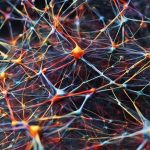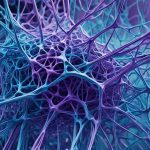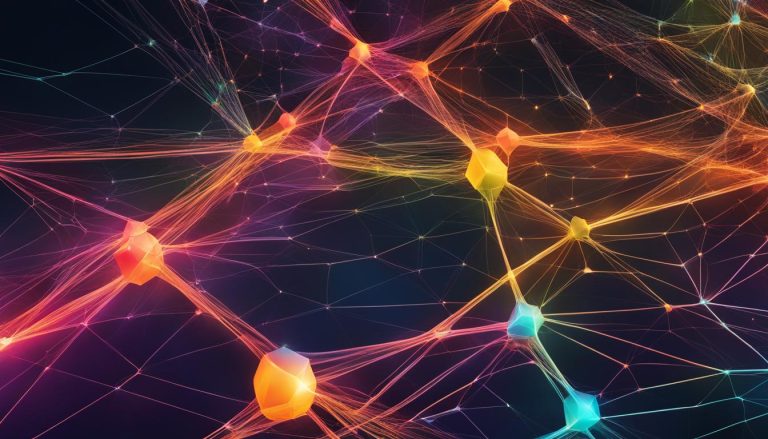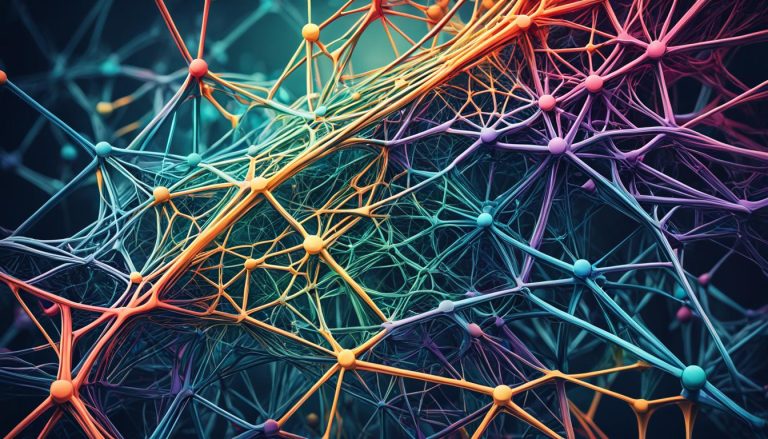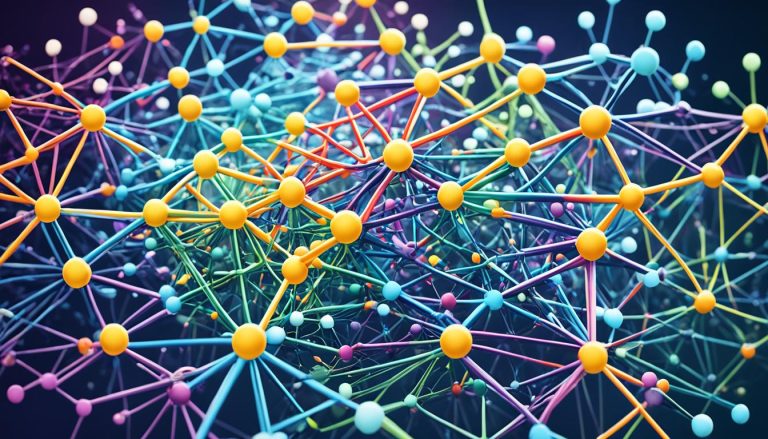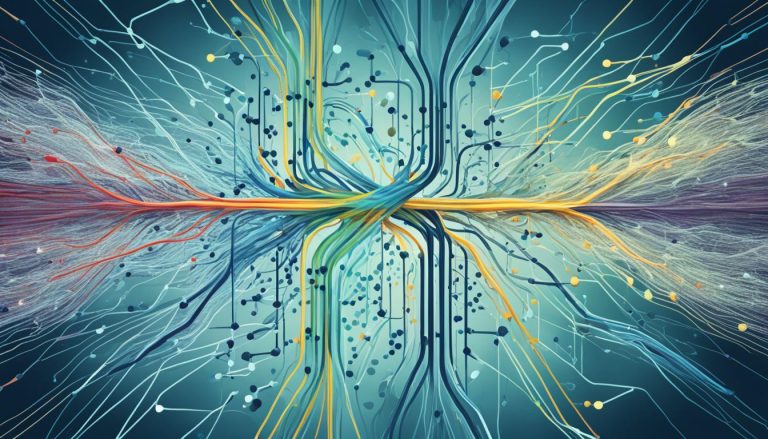Welcome to the world of Boltzmann Machines, where complexity meets artificial intelligence. In this article, we will delve into the analysis of Boltzmann Machines and uncover the intricacies behind their complexity.
As a type of complex system, Boltzmann Machines possess the remarkable ability of emergence and self-organization. These machines are widely utilized in the study of networks and stochastic networks, where complexity arises from stochastic interactions.
To quantitatively measure the complexity of Boltzmann Machines, information-theoretic measures play a vital role. Measures such as multi-information, synergistic information, total information flow, and geometric integrated information enable us to decode and quantify the intricate nature of these machines, ultimately unlocking their full potential in artificial intelligence applications.
By unraveling the complexity of Boltzmann Machines, we gain valuable insights into their inner workings and expand our understanding of the broader field of artificial intelligence.
Join us as we unravel the complexity behind Boltzmann Machines, unlocking the power within these AI marvels.
Understanding Complex Systems
Complex systems are fascinating entities that are composed of many simpler sub-units, each following local rules. These sub-units interact with each other in intricate ways, leading to the emergence of collective properties and the formation of higher-level structures. This phenomenon, known as emergence, is a central characteristic of complex systems.
Complex systems exhibit self-organization, meaning that they spontaneously arrange themselves into patterns or structures without any external instructions or central authority. This self-organization is a result of the interactions and feedback loops between the sub-units, which give rise to coherent and organized behavior.
The study of complex systems involves investigating how these systems behave, evolve, and adapt over time. By understanding the underlying dynamics and properties of complex systems, we can gain insights into a wide range of fields, including biology, physics, economics, and social sciences.
Measuring and quantifying the complexity of complex systems is a challenging task. However, various techniques have been developed to analyze and understand the intricate nature of these systems. Information theory, for example, provides a framework for quantifying the information content and patterns within complex systems. Kolmogorov complexity, on the other hand, measures the shortest possible description of a system, revealing its inherent complexity.
“Complex systems are like intricate puzzles, with each piece influencing and shaping the whole. Understanding their behavior requires a multidisciplinary approach and the utilization of sophisticated analytical tools.”
Boltzmann Machines are a prime example of a complex system that can be analyzed using information-theoretic measures. These probabilistic graphical models consist of interconnected nodes that interact with each other in a stochastic manner. The emergent behavior of Boltzmann Machines allows them to learn and represent complex patterns in data, making them valuable in the field of artificial intelligence.
Key Attributes of Complex Systems
- Composed of simpler sub-units
- Follow local rules
- Exhibit emergent properties
- Self-organize to create higher-level structures
Techniques for Analyzing Complex Systems
- Information theory
- Kolmogorov complexity
- Network analysis
- Agent-based modeling
- Nonlinear dynamics
By delving into the intricacies of complex systems and leveraging analytical techniques, we can unlock a deeper understanding of the world around us and harness the power of these systems in various domains.
Introduction to Boltzmann Machines
Boltzmann Machines are a versatile type of feature extraction algorithm that plays a crucial role in artificial intelligence applications. With their ability to reduce the dimensionality of input data and extract meaningful features, Boltzmann Machines unleash the hidden potential in high-dimensional datasets. These extracted features serve as building blocks for various tasks like clustering, classification, and many others. By incorporating Boltzmann Machines into a broader machine learning framework, researchers and practitioners can achieve superior results in their projects.
The power of Boltzmann Machines lies in their ability to seamlessly integrate with deep learning models. Their feature extraction capabilities make them an ideal complement to other machine learning algorithms. By extracting crucial features from raw data, Boltzmann Machines enable more efficient and accurate learning in subsequent stages. This integration allows for the advancement of artificial intelligence applications with enhanced performance and predictive capabilities.
One powerful application of Boltzmann Machines is in unsupervised learning, where the algorithms automatically learn patterns and relationships in the data without any explicit labeling. With their feature extraction capabilities, Boltzmann Machines can identify hidden structures and correlations within the data, enabling insights and discoveries that were previously unattainable.
Boltzmann Machines are a fundamental tool in artificial intelligence, enabling the extraction of meaningful features from complex datasets, and facilitating the development of more accurate and efficient machine learning models.
Boltzmann Machines operate by simulating the behavior of a collection of interconnected binary units, where these units represent neurons or variables in the dataset. Through a process known as Gibbs sampling, Boltzmann Machines iteratively adjust the connections between these binary units to find the optimal configuration that best represents the underlying patterns in the data.
The Boltzmann Machine Learning Process
- Initialize the Boltzmann Machine with random weights and biases.
- Present an input to the Boltzmann Machine and compute the activations of each binary unit.
- Update the connections between the binary units based on the computed activations using the Gibbs sampling algorithm.
- Repeat steps 2 and 3 for a specified number of iterations or until convergence.
- Use the learned connections to extract meaningful features from the input data.
Boltzmann Machines are trained using unsupervised learning techniques, meaning they do not require labeled data to extract features successfully. This unsupervised learning paradigm makes Boltzmann Machines well-suited for scenarios where labeled data is scarce or not available. The ability to extract features from unlabelled data expands the capability to mine insights from vast amounts of untapped information.
Additionally, Boltzmann Machines provide solutions to challenges faced in various domains, including image recognition, text analysis, and recommendation systems. Their ability to capture complex relationships within inputs makes them valuable in situations where traditional feature extraction approaches fall short.

Integrating Boltzmann Machines with Deep Learning
Boltzmann Machines are highly compatible with deep learning architectures, enabling the construction of powerful and sophisticated models. Their ability to extract features is enhanced when combined with deep learning models, elevating both the accuracy and interpretability of the results.
The integration process is seamless, with Boltzmann Machines serving as a preprocessing step to extract meaningful features from the input data. These features are then fed into the deep learning model, which focuses on learning the underlying patterns during training. By leveraging the strengths of both approaches, this combination enhances the performance and generalization capabilities of the overall system.
In conclusion, Boltzmann Machines play a significant role in the field of artificial intelligence, particularly in feature extraction. With their ability to reduce dimensionality and extract meaningful features from complex datasets, Boltzmann Machines contribute to the advancement of various applications such as clustering, classification, and unsupervised learning. The integration of Boltzmann Machines with deep learning models further amplifies their effectiveness, opening up new frontiers for innovation and discovery in the realm of artificial intelligence.
Feature Extraction with Boltzmann Machines
Feature extraction is a crucial step in many machine learning tasks, such as clustering and classification. Boltzmann Machines offer a powerful approach to feature extraction by transforming high-dimensional input data into a lower-dimensional feature vector. This process not only reduces the dimensionality of the data but also helps to combat the issue of overfitting, a common problem in machine learning.
Overfitting occurs when a model becomes too complex and starts to memorize the training data instead of learning general patterns. By extracting meaningful features with Boltzmann Machines, we can simplify the data representation, making it more generalizable to unseen examples. This ultimately improves the model’s ability to perform well on new data.
However, it’s important to strike a balance when choosing the number of output dimensions in a Boltzmann Machine. Increasing the number of dimensions may capture more information from the input data, but it can also lead to a higher risk of overfitting. On the other hand, decreasing the dimensions too much may result in information loss, where important patterns and variations in the data are not adequately captured.
The choice of output dimensions is a crucial hyperparameter that needs careful consideration. It requires understanding the specific problem, the nature of the data, and the desired trade-off between information loss and computational efficiency. Cross-validation and other model selection techniques can help in determining the optimal number of dimensions to achieve the best balance.
To assess the quality of the extracted features, it is common to reconstruct the original data from the lower-dimensional feature vector. This reconstruction process evaluates how well the extracted features capture the essential information present in the original data. It provides valuable insights into the effectiveness of the feature extraction process and helps iterate and refine the model if necessary.
The reconstructed data can be evaluated using various metrics, such as mean squared error or cosine similarity. These metrics quantify the discrepancy between the original data and the reconstructed data, providing a quantitative measure of how much information is lost during feature extraction.
In summary, feature extraction with Boltzmann Machines is a powerful technique to reduce overfitting and improve the efficiency of subsequent machine learning tasks. By carefully selecting the number of output dimensions, practitioners can strike a balance between preventing overfitting and minimizing information loss. The reconstruction process acts as a quality check, ensuring that the extracted features capture the essential information from the original data.
| Pros of Feature Extraction with Boltzmann Machines | Cons of Feature Extraction with Boltzmann Machines |
|---|---|
|
|
Feature extraction with Boltzmann Machines offers a powerful solution to manage the complexities of high-dimensional data. By employing careful hyperparameter selection and evaluating the quality of the extracted features, practitioners can leverage these algorithms effectively. This enhances the capabilities of subsequent machine learning tasks, such as clustering and classification.

The Encoding and Decoding Formulas of RBMs
In the world of artificial intelligence (AI), Restricted Boltzmann Machines (RBMs) play a crucial role in feature extraction. RBMs utilize an encoding formula to transform high-dimensional input vectors into lower-dimensional feature vectors, and a decoding formula to reconstruct the original high-dimensional input vector. These formulas allow RBMs to effectively perform tasks such as dimensionality reduction, clustering, and classification.
The encoding formula of an RBM involves the following steps:
- Multiplying the input vector by a weight matrix
- Adding a bias vector to the result
- Applying a sigmoid function to each element
This process generates a lower-dimensional feature vector that captures meaningful information from the input data. The sigmoid function, commonly used in RBMs, helps to introduce non-linearity and capture complex patterns in the data.
The decoding formula of an RBM follows a similar process to reverse the encoding and reconstruct the original high-dimensional input vector. It utilizes the same weight matrix as the encoding formula, but applies a different bias vector. This reconstruction process allows researchers and practitioners to assess the quality of the extracted features and evaluate the performance of RBMs.
The encoding and decoding formulas of RBMs are the building blocks for understanding the inner workings of these powerful algorithms. By manipulating the weight matrix and bias vectors, researchers can optimize RBMs for specific tasks, improve the quality of extracted features, and enhance the overall performance of AI systems.
Assumptions and Limitations of RBMs
Restricted Boltzmann Machines (RBMs) are powerful models used in various domains for modeling interactions and capturing dependencies in data. However, RBMs operate under certain assumptions and limitations that are important to consider.
Firstly, RBMs assume that their inputs are vectors of Bernoulli variables, which can only take on two possible states: 0 or 1. This assumption allows RBMs to effectively model the interactions between the variables and learn meaningful representations. By treating the inputs as Bernoulli variables, RBMs can capture the probabilistic nature of the data and estimate the likelihood of different states.
However, the assumption of Bernoulli variables imposes restrictions on the types of data that can be effectively modeled by RBMs. For example, continuous data or variables that can take on more than two states may not be suitable for RBMs without additional transformations or adaptations.
To address this limitation, extensions to RBMs have been developed to cater to different data types and relax the assumption of Bernoulli variables. Variants such as Gaussian RBMs and softmax RBMs allow for the modeling of continuous and multi-valued data, respectively. These extensions broaden the versatility of RBMs and enable them to handle diverse datasets across various domains.
Key takeaway: While RBMs assume a specific data type and have limitations with respect to modeling continuous or multi-valued data, it is important to consider alternative RBM variants when working with such data. These extensions allow for greater flexibility in modeling different types of data and expanding the applicability of RBMs in various domains.
Conclusion
Boltzmann Machines are a powerful tool in the field of artificial intelligence, offering a range of benefits for feature extraction and complexity analysis. These algorithms excel at extracting meaningful features from high-dimensional data, helping to uncover valuable insights and patterns. Through the reduction of overfitting, Boltzmann Machines enhance the efficiency and accuracy of subsequent tasks such as clustering and classification.
By gaining a deep understanding of the principles and formulas of RBMs, researchers and practitioners can make informed decisions about the optimal use and fine-tuning of Boltzmann Machines in their projects. These algorithms have the potential to transform data analysis and decision-making processes, enabling organizations to gain a competitive edge in the rapidly evolving world of artificial intelligence.
As the importance of extracting valuable information from complex and high-dimensional datasets continues to grow, Boltzmann Machines offer a versatile and effective solution. Their ability to handle complexity and improve feature extraction make them an essential tool for researchers, data scientists, and AI practitioners. Incorporating Boltzmann Machines into the AI toolkit can unlock new possibilities in understanding and using complex systems, paving the way for advances in various fields.
FAQ
What are Boltzmann Machines?
Boltzmann Machines are a type of complex system that is characterized by emergence and self-organization. They are often used in the study of networks and stochastic networks, where complexity is directly related to stochastic interaction.
How is the complexity of Boltzmann Machines quantified?
Information-theoretic measures, such as multi-information, synergistic information, total information flow, and geometric integrated information, are commonly used to quantify the complexity of Boltzmann Machines.
What are complex systems?
Complex systems are composed of many simpler sub-units that follow local rules. They exhibit emergent properties and self-organize to create higher-level structures. The study of complex systems involves measuring and quantifying their complexity using various techniques, such as information theory and Kolmogorov complexity.
How are Boltzmann Machines used in artificial intelligence?
Boltzmann Machines are a type of feature extraction algorithm that can be used in artificial intelligence applications. They reduce the dimensionality of input data and extract meaningful features that can be used for clustering, classification, and other tasks. Boltzmann Machines can be combined with other machine learning models and seamlessly integrate with deep learning models.
What is feature extraction with Boltzmann Machines?
Feature extraction with Boltzmann Machines involves transforming high-dimensional input data into a lower-dimensional feature vector. This helps to reduce overfitting and improve the efficiency of subsequent tasks, such as clustering and classification. The number of output dimensions in a Boltzmann Machine is an important hyperparameter that needs to be carefully chosen to balance information loss and computational efficiency. The reconstruction process can be used to assess the quality of the extracted features.
What is the encoding and decoding process of Restricted Boltzmann Machines (RBMs)?
The encoding process involves multiplying the input vector by a weight matrix, adding a bias vector, and applying a sigmoid function to each element to produce a lower-dimensional feature vector. The decoding process uses the same weight matrix and applies a different bias vector to reconstruct the original high-dimensional input vector.
What assumptions and limitations do RBMs have?
Restricted Boltzmann Machines assume that their inputs are vectors of Bernoulli variables, which have only two possible states (0 and 1). This assumption allows RBMs to model interactions between the variables and capture dependencies in the data. However, it also imposes limitations on the types of data that can be effectively modeled by RBMs. Extensions to RBMs have been developed to relax this assumption and allow for more flexibility in modeling different types of data.
How can Boltzmann Machines be used in the field of artificial intelligence?
Boltzmann Machines are a powerful tool in the field of artificial intelligence for feature extraction and complexity analysis. They can effectively extract meaningful features from high-dimensional data, reduce overfitting, and improve the efficiency of subsequent tasks. By understanding the principles and formulas of RBMs, researchers and practitioners can make informed decisions about the use and optimization of these algorithms in their projects.











